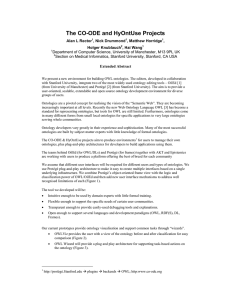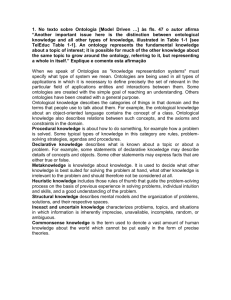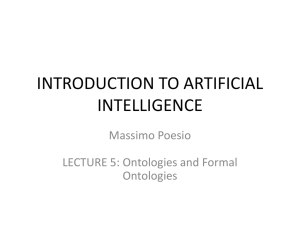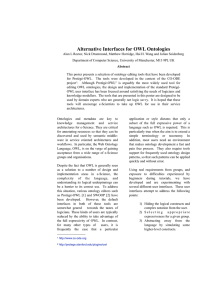Experiences of linking ontologies to a geospatial database Research & Innovation
advertisement
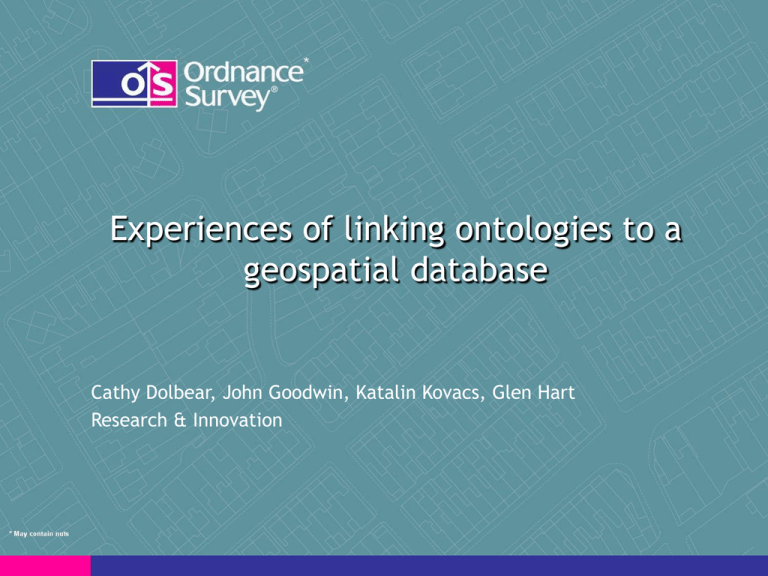
Experiences of linking ontologies to a
geospatial database
Cathy Dolbear, John Goodwin, Katalin Kovacs, Glen Hart
Research & Innovation
Overview
Introduction to Ordnance Survey’s data
Authoring topographic ontologies
Open world modelling, closed world thinking
Linking ontologies to our database
Immature technology
Introduction to Ordnance Survey
National Mapping Agency of Great Britain
Digital data accounts for 80% of business
activity
3.5 terabytes of contiguous feature based
data
5,000 updates a day, change captured
within 6 months
2000+ Concepts
OS MasterMap – integrated layers
Overview
Introduction to Ordnance Survey’s data
Authoring topographic ontologies
Open world modelling, closed world thinking
Linking ontologies to our database
Immature technology
Our approach to ontologies
Capturing organisational knowledge about topography
Driving database modelling vs using legacy systems
Up to 80% of applications have a geospatial component
Topography not a stand-alone application
Our data nearly always integrated with other datasets
Authoring topographic ontologies
Domain Ontology
Conceptual
Aspect
Built by
domain
expert
A River
Stretch is
part of a
River
River_
Stretch
direct_part_of
∃ River
Computational
Aspect
Ontology
engineer
translates
into OWL
<owl:ObjectProperty rdf:ID="directPartOf">
<rdf:type rdf:resource="&owl;FunctionalProperty"/>
</owl:ObjectProperty>
<owl:Class rdf:ID="River"/>
<owl:Class rdf:ID="RiverStretch">
<rdfs:subClassOf>
<owl:Restriction>
<owl:onProperty rdf:resource="#directPartOf"/>
<owl:someValuesFrom rdf:resource="#River"/>
</owl:Restriction>
</rdfs:subClassOf>
</owl:Class>
Domain experts think in a closed world
Structured sentences default to disjoint, XOR etc.
“River can overlap with Stream”
Closure axioms are needed
“A River flows into the Sea or a Lake or a River”
(it has to flow into something, and can only
flow into these things, and nothing else)
Difficulties in modelling “sometimes” or “may” in OWL
“A Channel may contain Water”
(All Channels enable Some ContainmentOfWater
All TypicalChannels contain Some Water)
Ontologies vs Databases: Issues
Is it an instance or a concept?
Water
Winter
Should it be stored in the ontology or database?
East Anglia, Midlands, the Fens
“A Burn is a Stream in Scotland”
Identity
Identity of Place - Topographic Identifiers (TOIDs)
Woodland
Naming
Land
Networks
cover
geography
Itchen Valley
Southampton, Basset
A Road
Populated Land
Roundabout
Overview
Introduction to Ordnance Survey’s data
Authoring topographic ontologies
Open world modelling, closed world thinking
Linking ontologies to our database
Immature technology
Data repurposing using ontologies
has Form
Sluice Gate
Ordnance
Survey
ontology
has Form
Weir
Sluice
Weir
Is a
Flood
defence
Is a
Environment
Agency
ontology
OS
Database
Database - ontology mapping
SPARQL
query
Query
result
D2RQ Server
Joseki SPARQL service
JDBC
connection
Oracle spatial
database
D2RQ
RDF virtual
graph
D2RQ Map
Jena
OWL ontology
DIG reasoner
(e.g. Pellet)
Database & ontology structural differences
Ontologies designed to work with RDF triple data,
not relational databases
Don’t bury semantics in mapping file
Efficiency is a big issue
hasFootprint
hasTOID
Building
Footprint
has Use
TOID
Use
is a
University
Building
is a
Database Feature Table
TOID
Type
Form
1234
Building
Church Place of Worship SDO_GEOMETRY
Shape
5678 Inland Water
River
Inland Navigation SDO_GEOMETRY
9101
House
Residence
Residence
…
House
Function
Building
….
…
….
SDO_GEOMETRY
SDO_GEOMETRY
How can we do this…
Ontology: River -> flowsInto some Sea
Data:
Forth rdf:type River
Tay rdf:type River
Clyde rdf:type River
Forth flowsInto North_Sea
Tay flowsInto North_Sea
North_Sea rdf:type Sea
Query:
select ?a
where {?b rdf:type Sea
?a flowsInto ?b}
Closed World result: Forth, Tay
Open World result: Clyde as well.
Summary
Domain experts find open-world thinking difficult
Software tools still have some way to go
Ontologies will help improve database design
Open world vs closed world isn’t our biggest problem
– content is.


